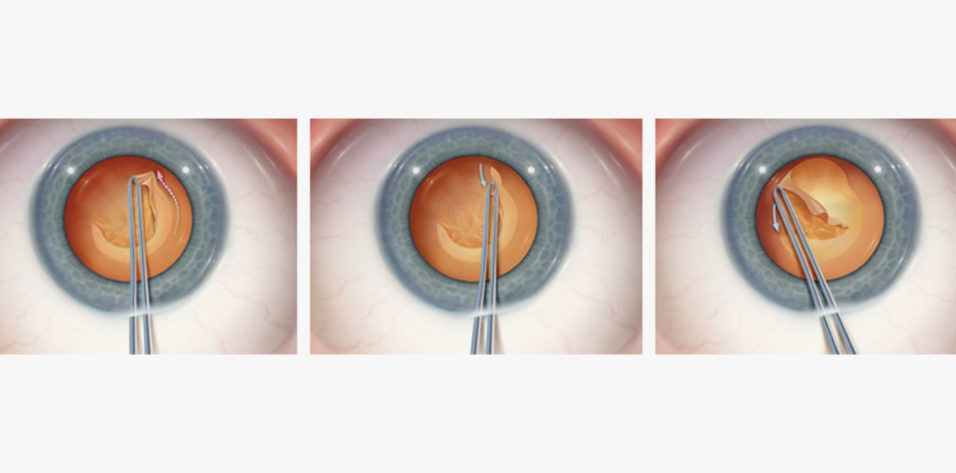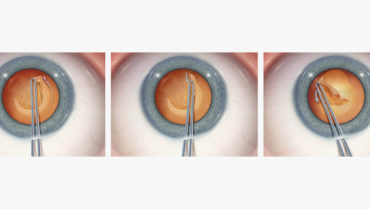

The development of continuous curvilinear capsulorhexis (CCC) in the late 1980s and early 1990s proved to be a major step in improving both the safety of phacoemulsification and the reliability of posterior IOL centration.1-4 Before CCC, the most common anterior capsulotomy technique involved the creation of numerous small tears connecting in a circular fashion. Mechanical stress on the margins of these can-opener capsulotomies, however, often led to the development of larger radial tears that zipped around the lens equator and led to intraoperative rents in the posterior capsule. After the introduction of CCC, surgeons around the world gradually adopted this procedure as their favored capsulotomy technique.
The problem with CCC initially, however, was that it was difficult to perform reliably. The greatest challenge was preventing the continuous anterior capsular tear from veering off peripherally toward the lens equator. Certain measures for preventing the development of an errant tear were rapidly embraced, such as fully filling the anterior chamber with a cohesive OVD to flatten the lens-iris diaphragm and trying to pull the leading edge of the tear somewhat centrally. The problem of rescuing an errant tear reliably, however, was not solved until the next decade.
During an instructional laboratory course on CCC at the 2004 ESCRS Annual Meeting, Brian Little, MA, DO, FRCS, FRCOphth, casually mentioned to one of the other instructors, Mark Packer, MD, he had learned a new trick. Dr. Little had noticed that he could reverse the direction of an errant CCC by simply redirecting the forces in the direction opposite from that of the tear. This trick was tried successfully several times in the adjacent wet lab, and soon an article by Little and Packer describing the Little maneuver was published.5
STEP BY STEP
The steps of the Little maneuver are best understood using illustrations. The maneuver comes into play when, during the creation of a CCC, the leading edge of the tear takes off and veers peripherally (Figure 1, left).

Figure 1. During the creation of a capsulorhexis, the leading edge of the tear takes off and veers peripherally (left). The margin of the leading edge of the tear is regrasped with capsular forceps as close to the root of the tear as possible, and the capsule margin is pulled in the opposite direction from the completed circumferential capsular tear (middle). When forces are applied in the direction opposite from the direction of the errant tear and in the plane of the lens, the surgeon can make a quick and easy redirection of the errant tear (right).
Early recognition of an errant capsulorhexis makes correction of these minor deviations easy. The margin of the leading edge of the tear is regrasped with capsule forceps as close to the root of the tear as possible, and the capsule margin is then pulled in the direction opposite from that of the completed circumferential capsular tear (Figure 1, middle).
Care must be taken not to lift the forceps but rather to pull in the horizontal plane of the anterior surface of the lens (Figure 1, right). When the forces are applied in the direction opposite to the direction of the errant tear and in the plane of the lens, the surgeon can make a quick and easy redirection of the errant tear.
However, if the errant tear extends under the iris and the leading edge is not easily visualized, the surgeon should immediately stop and use OVD to unfold the central capsular flap and push the flap flat against the lens (Figure 2, left). In these cases of more severe tear-out, it is helpful to use capsular microforceps, such as the Siebel 23-gauge forceps (MicroSurgical Technology). These forceps can be introduced through a 1-mm sideport incision, and they allow the surgeon to maintain precise control and approach the margin of the tear at the most advantageous angle to create the optimal reverse capsular force.

Figure 2. If the errant tear extends under the iris and the leading edge is not easily visualized, the surgeon should immediately stop and use OVD to unfold the central capsular flap and push the flap flat against the lens using capsular microforceps through a 1-mm sideport incision (left). The forceps are used to grasp the peripheral tear as close to the leading edge as possible and direct the force in the opposite direction from the errant tear (middle). As long as the errant tear has not reached the equator of the lens, the leading edge of the tear will then circle back into view. Once the leading edge is visualized, the forceps may be used to regrasp the leading edge of the capsulotomy and redirect the tear to complete the CCC (right).
The forceps are used to grasp the peripheral tear as close to the leading edge as possible, and the force is directed in the reverse direction of the errant tear (Figure 2, middle). As long as the errant tear has not reached the equator of the lens, the leading edge of the tear will then circle back into view (Figure 2, right). Once the leading edge is visualized, the forceps may be used to regrasp the leading edge of the capsulotomy and redirect the tear to complete the CCC.
CONCLUSION
As simple as the Little maneuver seems, it would be difficult to overstate its importance to modern cataract surgery. This easily performed maneuver has helped tens of thousands of cataract surgeons to stay out of trouble, regardless of their level of experience, and has become a mainstay of the bag of tricks that helps all of us to provide better surgical outcomes for our patients.
1. Fercho C. Continuous circular tear anterior capsulotomy. Paper presented at: Welsh Cataract Congress; September 1986; Houston, TX.
2. Neuhann T. Theorie und Operationstechnik der Kapsulorhexis. Klin Monatsbl Augenheilkd. 1987;190:542-545.
3. Gimbel HV, Neuhann T. Development, advantages, and methods of the continuous circular capsulorhexis technique. J Cataract Refract Surg. 1990;16:31-37.
4. Colvard DM, Dunn SA. Improved intraocular lens centration following capsulorrhexis. J Cataract Refract Surg. 1990;16(3):312-314.
5. Little BC, Smith JH, Packer M. Little capsulorhexis tear-out rescue. J Cataract Refract Surg. 2006;32:1420-1422.




